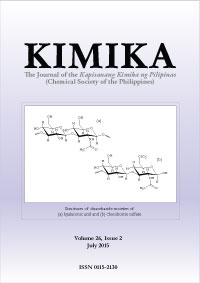Omega-3 Fatty Acids versus Heavy Metals: A Quantitative Estimation of the Benefit-Risk Ratio for the Consumption of Commonly-Consumed Fish and Products in Metro Manila
DOI:
https://doi.org/10.26534/kimika.v26i2.39-50Keywords:
ω-3 polyunsaturated fatty acids n-3 (PUFA), EPA, DHA, heavy metals, benefit-risk ratioAbstract
Fish and other marine products consumption is the main route of heavy metal exposure to human which poses health risks if taken in high dosage. On the other hand, the nutritional benefits of fish are mainly due to the content of high-quality protein and high content of the two kinds of omega-3 polyunsaturated fatty acids (PUFA): eicosapentaenoic acid (EPA) and docosahexaenoic acid (DHA). The study aims to assess and compare the benefit-risk ratio for the consumption of commonly-consumed fish and products in Metro Manila. Fish and product samples were analyzed for moisture, crude fat, heavy metals (As, Cd, Pb) and fatty acid profile (saturated, mono- and polyunsaturated) including omega-3 fatty acids EPA and DHA. These findings generally indicate that the consumption of fish and products studied posed no risk to human health. Essential fatty acids EPA and DHA were highest for dried anchovy, Stolephorus indicus (1.5 and 7.3mg/g sample); mussel, Mytilus smaragdinus (1.5 and 1.0mg/g sample); round scad, Decapterus macrosoma (0.9 and 3.4mg/g sample); and skipjack tuna, Auxis thazard (1.1 and 3.9mg/g sample). The hazard quotients of essential fatty acids versus heavy metals were also less than 1 except for Cd in squid (1.8), In the case of dried sardine (19.9), squid (1.8), shrimp (3.4), and skipjack tuna (1.7), these foods should be monitored regularly. In conclusion, the target hazard quotients for most of the fish and products showed values less than 1, which suggest that health risks were insignificant.Downloads
Published
2016-02-01
How to Cite
Briones, D. P., & Lazaro-Llanos, N. (2016). Omega-3 Fatty Acids versus Heavy Metals: A Quantitative Estimation of the Benefit-Risk Ratio for the Consumption of Commonly-Consumed Fish and Products in Metro Manila. KIMIKA, 26(2), 39–50. https://doi.org/10.26534/kimika.v26i2.39-50
Issue
Section
Research Articles
License
Authors who publish with this journal agree to the following terms:
- Authors retain copyright and grant the journal right of first publication with the work simultaneously licensed under a Creative Commons Attribution License that allows others to share the work with an acknowledgement of the work's authorship and initial publication in this journal.
- Authors are able to enter into separate, additional contractual arrangements for the non-exclusive distribution of the journal's published version of the work (e.g., post it to an institutional repository or publish it in a book), with an acknowledgement of its initial publication in this journal.
- Authors are permitted and encouraged to post their work online (e.g., in institutional repositories or on their website) prior to and during the submission process, as it can lead to productive exchanges, as well as earlier and greater citation of published work (See The Effect of Open Access).





